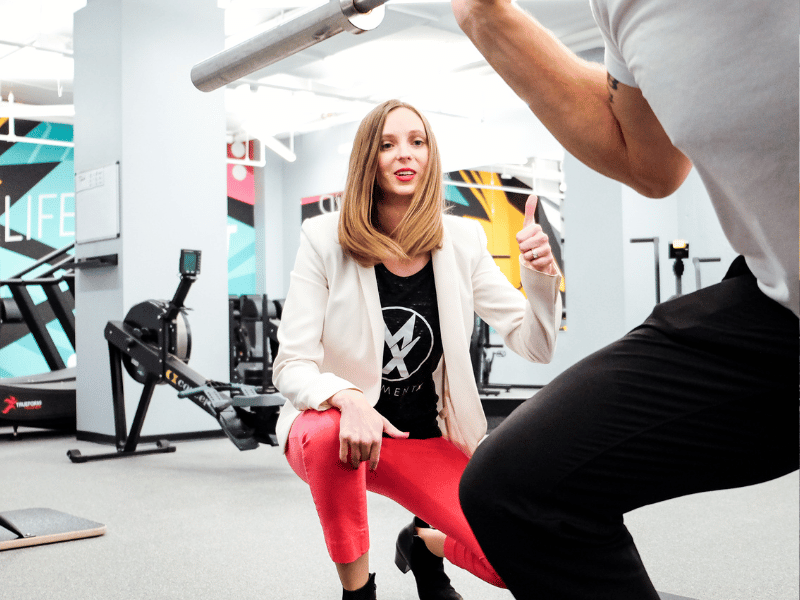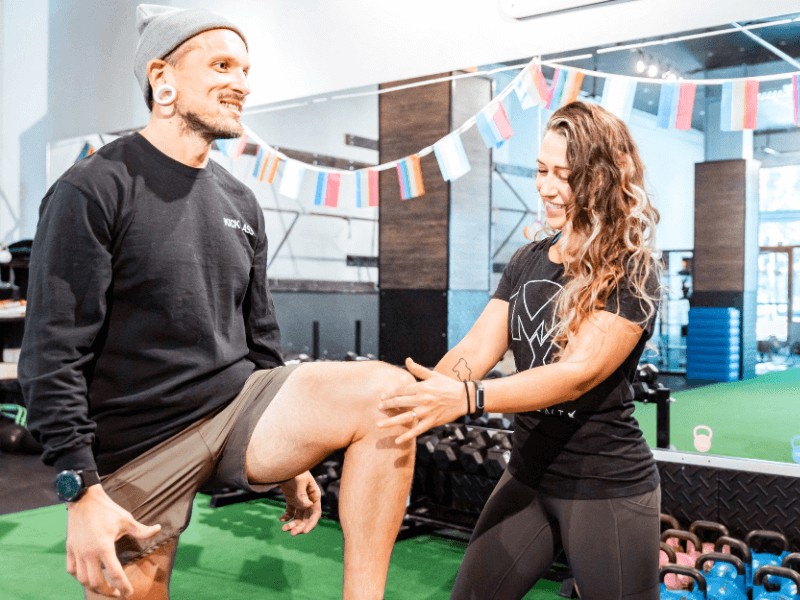Easing Arthritis Pain: Your Comprehensive Guide to Living with Osteoarthritis
Is knee pain holding you back from what you love such as running, biking, playing with your grandchildren or gardening? Or have you modified your exercise routine because your knees are too painful?
If the answer is yes to any of the above, know that you're not alone, and there is something you can do about it. I've seen countless patients over the years with these same issues who do quite well with a round of physical therapy treatment. Within a few sessions patients often get back to doing what they love.
Read on for information regarding knee pain, osteoarthritis and management strategies.
What is Osteoarthritis?
Osteoarthritis, often referred to simply as OA, is a degenerative joint disease that ranks as the most common form of arthritis. The Centers for Disease Control and Prevention (CDC) reports that approximately 32.5 million US adults are affected by osteoarthritis (1). It occurs when the cartilage that cushions the ends of bones in your joints gradually deteriorates (2).
Cartilage is a firm, slippery tissue that permits nearly frictionless joint motion. However, in osteoarthritis, the top layer of cartilage breaks down and wears away, allowing bones under the cartilage to rub together. This process can lead to pain, swelling, and reduced motion in the affected joint over time.
Unlike other types of arthritis that are systemic and can affect the entire body, osteoarthritis primarily affects the joints, particularly those that bear weight, such as the knees, hips, feet, and spine. It's also seen in joints used extensively or subjected to repetitive motions, including the fingers, thumbs, and lower back.
People living with OA can experience a significant impact on their quality of life. The condition can make it difficult to perform everyday tasks, contribute to chronic pain and disability, and diminish overall physical function.
Symptoms of Osteoarthritis
Living with osteoarthritis means experiencing a range of symptoms that can vary in severity and impact from person to person. These symptoms often develop gradually and worsen over time, reflecting the progressive nature of the condition. While the specific symptoms can depend on which joints are affected, there are commonalities that many individuals with OA experience. Recognizing these symptoms is a crucial step in seeking timely treatment and management strategies that can significantly improve your quality of life.
Here's a comprehensive list of the symptoms associated with OA that I commonly see in my practice:
- Pain: Affected joints may hurt during or after movement.
- Stiffness: Joint stiffness might be most noticeable upon waking up in the morning or after a period of inactivity.
- Tenderness: Your joints might feel tender when you apply light pressure.
- Loss of Flexibility: There may be a decreased range of motion in the affected joint, making it difficult to move the joint through its full range of motion.
- Grating or Grinding Sensation: You might feel a grating sensation when you use the joint, and you may hear popping or crackling.
- Swelling: This can be caused by soft tissue inflammation around the joint.'
- Bone Spurs: These extra bits of bone, which feel like hard lumps, can form around the affected joint.
- Weakness: The muscles around the joint may weaken. This can happen due to pain or reduced movement.
If you recognize these symptoms in yourself or a loved one, especially if they persist or worsen, seeking the advice of a healthcare professional like a physical therapist can provide you with the information and support needed to manage OA effectively.
Causes of Osteoarthritis
Osteoarthritis arises from a complex interplay of factors that can contribute to the breakdown of cartilage and the overall health of joints. While the exact cause of OA is not always clear, certain risk factors are frequently associated with the development and progression of the condition. It's important to understand that these factors can increase the likelihood of experiencing osteoarthritis but do not guarantee its occurrence. Here are some of the common causes and risk factors for osteoarthritis (3):
- Age: The risk of developing osteoarthritis increases with age, likely due to the wear and tear on joints over time.
- Sex: Women are more likely to develop OA, especially after menopause.
- Obesity: Extra body weight adds stress to weight-bearing joints, like hips and knees. Additionally, fat tissue produces proteins that may cause harmful inflammation in and around your joints.
- Joint Injuries: Injuries, such as those that occur from sports or accidents, can increase the risk of osteoarthritis. Even injuries that occurred many years ago and seemingly healed can increase the risk of OA in those joints.
- Repeated Stress on the Joint: If your job or a sport you play puts repetitive stress on a joint, that joint may eventually wear over time if not properly conditioned.
- Genetics: Some people inherit a tendency to develop OA.
- Bone Deformities: Some individuals born with malformed joints or defective cartilage can increase the risk of osteoarthritis.
Understanding these risk factors can help in identifying strategies for managing and potentially reducing the risk of osteoarthritis. For instance, maintaining a healthy weight and avoiding joint injuries can mitigate some of the risks. However, it's also crucial to recognize that some factors, such as age and genetics, are beyond one's control. In these cases, focusing on modifiable lifestyle factors and seeking professional guidance for early intervention can be beneficial strategies for managing the condition's impact on your life.
Treatment Options for Osteoarthritis
Managing OA requires a multifaceted approach that combines various treatment options tailored to individual needs and the severity of the condition. These treatments aim to relieve symptoms, improve joint function, and enhance the quality of life. Here is an overview of the primary treatment options for osteoarthritis:
Physical Therapy
Physical therapy is a cornerstone of OA treatment. A physical therapist can develop a personalized exercise program to strengthen the muscles around your joint, increase your range of motion, and reduce pain. Proper exercise is crucial in managing osteoarthritis, as it can enhance joint flexibility and support overall joint health (4).
Medications
Pain Relievers: Over-the-counter (OTC) pain relievers, such as acetaminophen, can reduce pain. It's important to use these as directed by your physician to avoid side effects.
Nonsteroidal Anti-inflammatory Drugs (NSAIDs): NSAIDs can sometimes relieve pain and reduce inflammation when advised by a professional.
Topical Treatments: OTC creams, gels, and patches can be applied directly to the joints to relieve pain with fewer side effects.
Corticosteroid Injections: These can provide rapid relief of inflammation and pain but are generally used sparingly due to potential side effects over time.
Lifestyle and Home Remedies
Exercise: Regular movement helps maintain flexibility in your joints. Low-impact exercises, such as swimming and biking, can be particularly beneficial.
Weight Management: Losing weight can reduce stress on weight-bearing joints, limit further injury, and increase mobility.
Heat and Cold Therapies: Applying heat or cold can relieve pain and stiffness in affected joints.
Assistive Devices: Tools like canes, shoe inserts, braces, and taping can help relieve stress on your joints.
Surgery
In more severe cases, when conservative treatments fail to alleviate symptoms, surgery like a partial or total joint replacement may be considered. Damaged joint surfaces are replaced with plastic and/or metal parts.
Alternative Therapies
Some people find relief from symptoms with acupuncture, massage, tai chi, and yoga. These therapies can help manage pain and improve flexibility.
While the above treatments can offer relief and improve function, physical therapy stands out for its ability to be customized to each individual's unique situation. In the next section, we'll explore in depth how physical therapy can play a pivotal role in managing osteoarthritis.
How Physical Therapy can help with Osteoarthritis
Physical therapy offers a tailored approach to managing osteoarthritis, focusing on reducing pain, improving function, and providing strategies for long-term health. Working with a skilled physical therapist allows for a personalized treatment plan that addresses the specific needs and goals of each individual. This personalized approach is crucial because OA affects everyone differently, and what works for one person may not be effective for another.
A physical therapist begins by conducting a thorough assessment of your joint health, mobility, strength, and daily activity levels. This evaluation forms the basis of your treatment plan, which often includes a combination of manual therapy techniques, targeted exercises, and education. Manual therapy, such as soft tissue massage and joint mobilization, can help to relieve pain and improve joint movement. These hands-on techniques are complemented by specific exercises designed to strengthen the muscles surrounding the affected joints, thereby providing better support and reducing the burden on the joints themselves.
In addition to in-clinic treatments, physical therapy for osteoarthritis includes an important educational component. Physical therapists with MovementX empower our patients with knowledge about their condition and teach them self-management techniques. This might include guidance on activity modification to avoid aggravating the joint, nutritional advice to support joint health, and strategies for managing symptoms at home.
Ultimately, physical therapy for arthritis is about more than just managing symptoms—it's about improving your ability to participate in daily activities and maintain a high quality of life. Through a combination of expert care, education, and personalized attention, physical therapy can help you navigate the challenges of osteoarthritis with confidence and resilience.
Prevention of Osteoarthritis
Preventing osteoarthritis or reducing the risk of its development focuses on maintaining joint health and overall wellbeing. While some risk factors, such as age and genetics, are beyond your control, there are several actionable steps you can take to protect your joints and potentially delay the onset of OA or mitigate its severity. Here are key strategies for anyone looking to support their joint health:
Maintain a Healthy Weight
Extra weight puts additional pressure on weight-bearing joints like hips, knees, and ankles, increasing the risk of osteoarthritis. Each pound of weight loss can significantly reduce the load on your knees and hips, decreasing wear and tear on these joints. Maintaining a healthy weight through a balanced diet and regular exercise is one of the most effective ways to prevent osteoarthritis or lessen its impact.
Stay Active
Regular physical activity strengthens the muscles around your joints, which helps protect them from wear and tear. Focus on low-impact exercises such as swimming, cycling, walking, and strength training. These activities improve joint flexibility and support without placing undue stress on the joints. Incorporating daily physical activity into your routine is essential for joint health.
Protect Your Joints
Be mindful of how you use your joints in daily activities. Use proper lifting techniques, carry bags in a way that distributes weight evenly, and avoid repetitive motions that can stress the joints. When participating in sports or physical activities, wear protective gear and ensure that you're using the correct technique to prevent joint injuries.
Improve Flexibility and Strength
Regular stretching exercises enhance flexibility, which can reduce the risk of joint injuries. Strength training, particularly for the muscles surrounding the joints, provides additional support and reduces the burden on the joints. A balanced exercise program that includes both flexibility and strength components is ideal for joint health.
Ensure Proper Nutrition
Nutrition plays a crucial role in maintaining healthy joints. Foods rich in omega-3 fatty acids, antioxidants, and vitamins can support joint health. Incorporate fish, nuts, seeds, fruits, and vegetables into your diet to help reduce inflammation and promote overall health.
Avoid Smoking and Limit Alcohol Consumption
Smoking and excessive alcohol consumption can affect bone health and increase the risk of osteoarthritis. Quitting smoking and moderating alcohol intake are positive steps toward preserving joint health.
Seek Early Treatment for Joint Injuries
Promptly addressing joint injuries can prevent them from leading to osteoarthritis later on. If you experience a joint injury, seek professional medical advice to ensure proper treatment and rehabilitation.
By integrating these preventative strategies into your lifestyle, you can actively contribute to the health of your joints and potentially reduce the risk of developing osteoarthritis. Remember, the best prevention plan is one that is consistent and adapted to your personal health needs and lifestyle.
Conclusion
As we've delved into the complexities of OA, it's clear that every step taken towards addressing your joint health is a step towards reclaiming the quality of life you deserve.
Now, ask yourself: How can you take control of your osteoarthritis today? Are there lifestyle changes you could implement to alleviate the stress on your joints? Have you considered how personalized physical therapy for arthritis could not only manage your symptoms but also improve your overall physical function?
OA doesn't have to be a path walked alone. The expertise and support of a skilled physical therapist can guide you through personalized strategies designed to meet your unique needs. Whether you're looking to manage pain, enhance mobility, or simply seek ways to live better with osteoarthritis, the right care can make all the difference.
Don't wait for the pain to decide for you. Take the first step towards a more active, fulfilling life by requesting a session with me, Dr. Adam Reinecker PT. Together, let's move towards a future where osteoarthritis doesn't limit your potential, but becomes a condition you manage confidently and successfully.
References
- https://www.cdc.gov/arthritis/data_statistics/arthritis-related-stats.htme
- Ma L, Cranney A, Holroyd-Leduc JM. Acute monoarthritis: what is the cause of my patient's painful swollen joint? CMAJ. 2009 Jan 06;180(1):59-65.
- Zhang Y, Jordan JM. Epidemiology of osteoarthritis. Clin Geriatr Med. 2010;26:355–69.
- Fernandes L., Hagen K. B., Bijlsma J. W. J., Andreassen O., Christensen P., Conaghan P. G., et al. (2013). EULAR recommendations for the non-pharmacological core management of hip and knee osteoarthritis. Ann. Rheum. Dis. 72, 1125–1135. 10.1136/annrheumdis-2012-202745
About the Author
Dr. Adam Reinecker is a physical therapist in the Tigard, Beaverton, and Portland, Oregon regions. Among Adam’s specialties are Sports Injuries, Orthopedic Conditions, and Post-Operative Care. When he’s not treating patients, you can find Adam leading an active lifestyle of skiing, mountain biking, running, and weight training.
Share This Page
More Conditions We Treat
Found this page interesting? Learn more about other conditions we treat:





